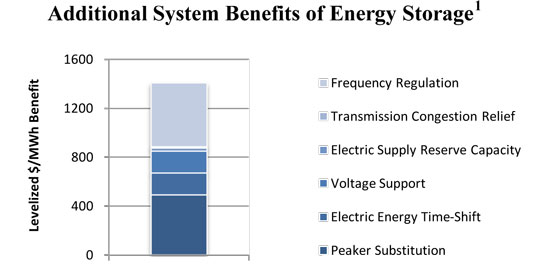How Storage Can Help Get Rid of Peaker Plants
Posted by Big Gav in energy storage
Greentech Media has an article on how energy storage can reduce spending on costly peaking plants - "Storage is cheaper, cleaner and ready to be implemented" - How Storage Can Help Get Rid of Peaker Plants (hat tip Bob).
Energy storage systems store energy for use at a later time, when electric power is most needed and most valuable, such as on hot summer afternoons. Energy storage helps integrate intermittent renewable sources, can supplant the most polluting power plants, and enhances grid reliability. There are many ways to store energy, including chemically (batteries), mechanically (flywheels) and thermally (ice).
Due to insufficient energy storage for the electric power grid, utilities must size their generation and transmission systems to deliver the full amount of electricity that consumers demand (or might demand) at any given moment of the year. Owning and operating sufficient assets to serve peak demand - only 5% or less of the hours per year - results in increased emissions and costs to electricity customers.
Energy storage has the unique potential to transform the electric utility industry by improving existing asset utilization, avoiding the building of new power plants, and avoiding or deferring upgrades to existing transmission and distribution networks. Scientists, utility CEO's, and policy makers frequently refer to energy storage as the "Holy Grail" for the electric power industry. The California State Senate will hold hearings on AB 2514, an assembly bill to to promote energy storage in the state. A complete white paper from Strategen can be found here.
More recently, energy storage has achieved recognition as a foundational element of the Smart Grid, and the technical community speaks of energy storage as a key enabling resource to facilitate the transition away from a fossil fuel dominated generation fleet to one that is cleaner, more reliant on renewables, "smarter," and able to accelerate the electrification of the transportation sector. The following analysis demonstrates the value of energy storage as an alternative to natural gas-fired peaker plants.
Energy Storage Technologies Today Can Deliver On-Peak Electricity at a Lower Cost than Gas-Fired Peakers
To help illustrate the cost effectiveness of energy storage, we compared the cost of a kilowatt-hour (kWh) of electricity generated on-peak by a gas-fired peaker, with the cost of a kWh of electricity provided on-peak by an energy storage system. For simplicity, this comparison selected a commercially available energy storage technology - lead-acid batteries - and used the cost and specifications similar to the large lead-acid energy storage peaking facility shown below. Located in Chino, California, this 10 megawatt (MW), 4 hour duration system successfully demonstrated energy storage's ability to manage peak load from 1988 through 1996.
Using assumptions taken from a recent California Energy Commission (CEC) study, our analysis found a levelized cost of generation for the simple cycle gas-fired peaker plant of $492 per megawatt-hour (MWh), or $203 per kilowatt-year (kW-yr). In comparison, the energy storage plant demonstrated significant savings, with a levelized cost of generation of $377 per MWh ($155/kw-yr).
Energy Storage Has the Ability to Deliver More than Peaker Substitution Value to the Grid
Energy storage provides multiple value streams above and beyond peaker substitution. For example, by their nature, gas-fired peaker plants cannot be economically sized below 50 MW and therefore are not easily installed in a distributed footprint. Energy storage systems do not have this limitation, opening up the potential for many technical and economical benefits available to distributed energy resources such as reduction of transmission and distribution losses. Additional benefits include electric energy time-shift, voltage support, electric supply reserve capacity, transmission congestion relief, and frequency regulation.






